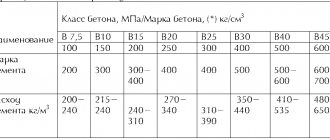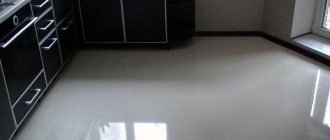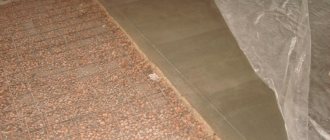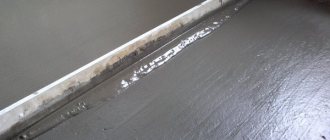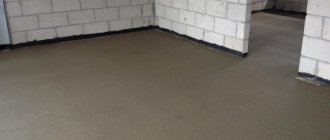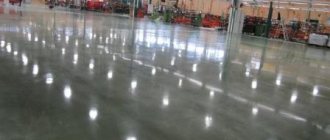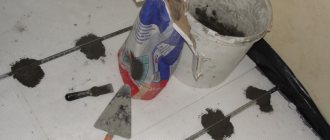Home |Construction |How to properly fill bath floors?
Date: January 17, 2019
Comments: 0
Bathhouse! This is not just a washing room, but the personification of centuries-old traditions. Here you can relax, forget about problems, cleanse your body and soul. Who hasn’t at least once thought about building a bathhouse in their country house? There are even enthusiasts who implement ideas in apartment buildings. We will talk about the construction of a bathhouse in the private sector, or rather, about how to fill the floor in a bathhouse in order to get a durable building that will please the owners for many years.
Traditionally, the floors in such rooms were made of wood. The service life was limited to several years. This is natural, because high humidity negatively affects wood. Guided by modern methodologies, it is possible to fill floors with concrete, which will significantly increase the service life of the foundation. It is important to adhere to technology when carrying out the process of pouring concrete in a bathhouse.
Concrete screed on the floor in the bathhouse is considered the best option
Relevance of the pouring process
Pouring the floor in a bathhouse is a rather serious process. There is a misconception that anyone can cope with this task. It would seem that he dug a hole, poured concrete on the base, leveled the covering and the floor was ready! With this approach, you risk getting a damp, cold base that does not perform its intended functions. After all, the floor in the bathhouse should:
- Be strong and durable.
- Provide good thermal insulation.
- Have the ability to drain water.
To get maximum pleasure from your bathing holiday, study the available materials for flooring before starting work, and consult with specialists.
Installation of a drain hole in different baths
There are not very many drain designs. They differ rather in the place of application. The design of the drain may be different for different types of baths.
Sauna drain
The floor drain in a sauna may not have the same throughput as in a steam bath: there are no water flows from the tubs, and the font has its own drain. In addition, as a rule, the sauna itself does not need a drain, and the sauna washing area does not need a tiled floor. This means that a classic drain with a drain is used there.
In a sauna with a tiled floor, you can use a classic drain with a drain and a water seal
It is not much different from a sauna drain.
Viega Advantix drain for installation in hammam and sauna
Drain in a Russian bath
Draining in a Russian steam bath is necessary in two rooms - the steam room and the washing room. Bath drains are different, which primarily depends on the design of the floor in the steam room and washing room. They are no different in design if the floors are the same in both. Let's look at different floors and different drains for these floors.
A steam drain can also be ordinary, with a drain
Dependence of the design on the floor of a Russian bath
The floors in a Russian bath are different.
- Leaky or torrential wooden floors - horizontal boards are not laid tightly, but with cracks for free flow of water over the entire floor area. This is a traditional design that has long been used in Russian baths. The main disadvantage is the need for thorough initial and subsequent regular treatment of boards with hydrophobic impregnations.
- Leak-resistant wooden floors - the boards are laid closely at a certain angle of inclination towards the drain hole so that water flows freely. The slope is carried out using slightly wedge-shaped logs.
- Tiled (only possible in the washing room). They are also laid with a slight slope towards the ladder. The slope is carried out either by creating a concrete base, or by using different thicknesses of mortar.
The drains for different genders of a Russian steam bath are strikingly different in design. But the largest variety of drains is found on pouring or leaky floors.
pouring floor
With the simplest method of water seeping through the entire floor into a drainage pad located under the entire bathhouse, there is no drainage device at all.
Drain through the pouring floor into the drainage pad; no drainage device
A more complex subfloor design: it slopes towards the concrete channel, preferably with insulation and screed. There is also no drain.
When draining into a concrete channel, there is also no drainage device
When draining into a concrete pit, the role of a water seal is performed by the pipe itself, located in a special way - with the possibility of air access.
The pipe in such a pit plays the role of a water seal
If the underground has a drain into the sewer, then in addition to insulating and waterproofing the underground, you need a simple drain with a water seal to prevent unpleasant odors from entering the underground, and from there into the bathhouse through the cracks in the floor.
When draining into the sewer from under a pouring floor, a simple drainage device is required
Non-leakage floor
The only possible solution here is a classic drain. It can be of different designs - from a complex modern drain to an ordinary, familiar siphon. The ladder is a compact and reliable design.
The drain will last a long time and is easy to clean
The siphon is cheap and familiar.
Scheme of drainage on a non-leaky floor in a bathhouse using a siphon
The question is your financial capabilities and the availability of space under the floor.
Required tools and materials
Having decided what types of coatings will be used when arranging bath rooms, you can begin to implement the pouring project. Let's look at how to properly fill a floor and what tools you will need. Concrete floors are recommended for washrooms and steam rooms.
Having given preference to concrete, do not forget that the high temperature of the steam room will lead to strong heating of the floor, and walking on it will not be comfortable. To optimize the temperature balance, additionally cover the concrete floor surface with cork or wooden panels. When improving the washroom area, leave the concrete uncoated or lay floor tiles - this is beautiful and aesthetically pleasing.
A concrete floor is essentially a concrete screed on top of which a waterproof, non-slip coating is laid.
To organize the workflow for pouring a floor, you will need the following tools:
- tape measure for taking measurements;
- building level to control base deviations during pouring;
- beacons necessary when forming the slope of a concrete surface;
- containers with which the concrete composition will be transferred from the mixing site to the room;
- concrete mixer;
- construction mixer or electric drill with a special attachment (when making concrete mortar manually);
- a device for compacting concrete mortar and removing air inclusions;
- trowel, a rule for leveling the surface of a concrete pavement.
The quantity and completeness of materials is determined individually for each construction project. To install a heated floor in a bathhouse with a slope, you will need the following materials:
- Crushed stone, medium gravel or expanded clay for backfilling the base.
- Portland cement, quarry sand, industrial water used when mixing concrete mortar.
- Additives, plasticizers that increase moisture resistance and strength characteristics of concrete.
- Waterproofing material (film 200 microns thick, roofing felt).
- Insulation material.
- Durable steel reinforcing mesh.
- Plumbing pipes, plugs, valves to form a system for draining water from the room.
When laid on the ground, the slope of the floor is ensured by creating a slope of the very base of the soil
Floor with drain over concrete screed in a timber bathhouse
Here a drain hole has already been installed in the concrete screed and the floor beams have been installed. All that remains is to insulate the underground with sheets of extruded polystyrene foam.
Prev 1of1 Next
Prev 1of1 Next
Prev 1of1 Next
Prev 1of1 Next
The insulation boards are fastened together with sealed foam and laid with a slope towards the drain. A layer of roofing felt waterproofing is laid on the crowns of the log house, on top of which a reflective vapor barrier for the walls of the steam room will be installed in the future.
Finally, the simplest elementary technology for draining a wooden floor from our ancestors. The floor is divided into two parts by a wooden channel running down the center. It is made of three boards and has a cross-section of an inverted letter P. This design with three walls resembles a square pipe without one plane and is installed in the center of the steam room with a slight slope towards the drain. The remaining floor boards on one and the other side of the gutter are mounted so as to form a slight slope towards it. The floor is made solid, without cracks, and all the water flows to the center and exits through the gutter into the sewer system.
First stage
Having prepared the tool and purchased the necessary materials, we begin the preparatory work. First we dig a drainage hole. Its task is the reception and subsequent disposal of wastewater. On the outgoing sewer pipe we install a valve, the so-called drain ladder, which:
- hermetically connects the drain and waste systems;
- thanks to the installed grille, it ensures filtration of incoming water, which significantly reduces the possibility of blockages;
- prevents gases from entering the sewer pits into the room, as it is equipped with a water seal located inside the siphon.
Depending on the location of the drain hole, a drain is used with a straight line (when the pipe exits strictly vertically) or a side connection (if it is horizontal). When purchasing a drain ladder, pay attention to its height, which is fundamental when calculating the height of the coating being formed.
Having prepared the drainage pit, lay out the sewer pipes. If the drain is located in the corner of the room, the pipe is laid along the wall. When the drain is located in the center of the base, the pipes are laid diagonally, avoiding bends as much as possible, which lead to the formation of unwanted blockages. The plumbing elements are connected and brought to the cesspool. When organizing drainage from several rooms, they distribute communications throughout the room. The trenches are filled with sand and compacted tightly. To prevent pipes from becoming clogged with debris while the floor is being poured, they are covered with special plugs or thick fabric.
Installation of bath floors, usually done on the ground or logs
Features of the drainage system
First of all, I would like to draw attention to the fact that the installation of sewerage in the bathhouse should be carried out even before the work on laying the floor https://techengroup.ru/pomesheniya/dlya-parkovok/.
At the same time, it does not matter much what material the floor in the bathhouse will be made of. Regardless of your choice of drainage device, before creating a sewer system, you must perform certain preparatory work.
Many people mistakenly hope that all the drainage from the bathhouse will be absorbed by the soil. However, this option for wastewater disposal leads to the soil being polluted and the soil being eroded. If you abandon the idea of creating a water drainage system, then after a short time from the moment the bathhouse begins to operate, you may encounter shrinkage of the structure, its main structures will begin to deform.
If the erected structure for paired procedures is intended for a family of three, and it is used only once a week, then in this case you don’t have to worry about installing a sewer system in the building if the bathhouse is built on sandy and sandy loam soils. In this case, a leaky floor is created to drain water. This work involves fixing the floor boards loosely. They are laid freely with a gap of 5 mm.
This allows you to lift the floor and dry it at any time. The drains that pass through such a floor are absorbed into the ground. If the amount of drainage from the bathhouse is large enough, then in this case it is worth installing a leak-proof floor in the building and creating a sewer system.
Main stages of floor construction
Upon completion of the arrangement of the drainage and sewer system, we begin to form the foundation for the future floor. For this:
- We create a cushion for pouring concrete mortar, which allows us to limit heat loss. We deepen the soil by 50 centimeters. Three quarters of the total volume is filled with construction waste that is not subject to rotting processes.
- We cover the resulting surface with clay and, after drying, pour a fifteen-centimeter shock-absorbing layer of sand with fine gravel or crushed stone. This level will allow the absorption of moisture that results from temperature changes. We carefully compact the layer, maintaining the slope specified by the project.
- Pour the first layer of concrete mortar. If possible, we use perlite additive - an excellent heat insulator. When working with perlite, pay attention to its properties - especially fine fraction and minimal weight. When mixing the concrete solution, use a room protected from the wind to avoid increased dust formation. The thickness of the first layer of concrete when pouring the base should not exceed 4-6 cm. We isolate the joints between the base and the walls from moisture penetration with bitumen.
- We wait for the solution to dry. It depends on weather conditions, the period ranges from several days to 2-3 weeks.
- We lay thermal insulation material.
To prevent it from being damaged by moisture, it is advisable to additionally use roofing felt for insulation. The most important thing in a bathhouse is the floor, which should be warm - The next stage is pouring the floor in the bathhouse with a second layer of concrete mortar. At this stage of work, a reinforcing mesh is used to protect the cement base from cracking during operation. We compact the concrete, trying to get rid of air cavities as much as possible.
- Leave the surface alone until completely dry. To ensure that concrete sets evenly during the hot season, we moisten the base using a sprayer.
- The final stage is applying the cement mixture to the entire surface and leveling the concrete according to the rule. Make sure that the slope of the covering is correct towards the drainage hole. Apply deep penetration waterproofing impregnation to the finished base.
We would like to focus your attention on the fact that if you do not plan to use the bathhouse during the cold season, then when mixing the concrete solution, you can exclude perlite from the recipe. Use the usual cement-sand composition of one to three, adding 1/10 of lime. This will reduce financial costs without reducing the strength of concrete.
Installation of a concrete floor with a drain in a bathhouse
Before pouring the floors in the bathhouse to drain the water, let's look at the sequence of installation of the entire floor structure in the washing compartment.
If your bathhouse building is built on a slab foundation, then you can start pouring the screed directly on the concrete base. Naturally, the slab must have a hole for the fan pipe equal to its outer diameter.
If your bathhouse is on an MZFL foundation or on a columnar / pile foundation, then the floor pie design will be relatively standard for this option.
First of all, floor joists are installed, which will perform three functions at once in this scheme:
- The logs will serve as the basis for the finished floor, which will be concrete in the washing area and wooden in the steam room.
- A subfloor will be attached to the joists, which will support the insulation underneath.
- The insulation you have chosen to insulate the bathhouse floor will be laid between the joists. For example, if you chose standard mineral wool slabs with a width of 60 cm, then it is worth making the distance between the logs 59 cm to simplify the installation of insulation in the bath floor.
After the logs are installed in place, a drainage system from sewer pipes is installed. Pipes with a cross section of 50 mm run from the washing compartment. If you are making a toilet in a bathhouse, then pipes with a cross-section of 110 mm will go from the toilet. After the toilet, wastewater should go either to a cesspool or to a septic tank - a house one or a separate bathhouse.
Should wastewater from the toilet and washing compartment be combined in a bathhouse? You can and should combine them. In this case, wastewater from the washing compartment will clean the pipe coming from the toilet and provide enough water for the operation of the septic tank, if it is equipped separately for the bathhouse.
After the pipes are installed, you can begin installing the subfloor. The subfloor in the bathhouse can be made from either boards or any suitable slab material. It can be DSP, plywood, OSB. If plywood is used, it will need to be impregnated with bioprotective compounds such as Senezh Bio.
After this, a floor insulation is installed between the floor joists, which will rest on the subfloor. As mentioned above, it is better to install the insulation between the joists.
Next, let's look at how to pour a screed in a bathhouse under the drain so that water is guaranteed to collect in one corner near the drain. For this purpose, any slab material is mounted on wooden logs. DSP is best suited for these purposes. Of course, cement particle boards are very susceptible to deformation if they swell from moisture. However, under a concrete screed this material will feel quite tolerable.
The slope of the floor in the washing compartment can be 0.3-0.5 cm per meter. In this case, moderately polluted water will be drained, so there is no longer any reason to make a slope.
After the screed has been made and the drain has been installed, you can begin installing the final floor covering. The best options for this scheme would be to use ceramic or porcelain tiles.
As you can see, a poured concrete floor in a bathhouse with a drain can be made with your own hands and according to a very simple scheme.
Which coating should you choose?
We briefly described how to fill a bathhouse floor with concrete. But leaving it in this form is not aesthetically pleasing, so we suggest dwelling on the question of what material to choose for flooring in a bathhouse with a slope. The optimal solution is tiles with a rough coating that prevents slipping on the floor. You can opt for small mosaics. It is easy to lay on the floor and adjust to the desired size.
Laying should begin from the drain:
- make sure that the ladder grate is flush with the tiles;
- carry out the work with a special glue that has increased adhesive parameters;
- Seal the seams with moisture-resistant grout that matches the color.
For a small bathhouse in a summer cottage, a simple covering of a pre-polished concrete floor with wooden or cork panels is suitable. It is important to choose the “right” wood, which, when exposed to high temperatures, will saturate the surrounding air with pleasant and healthy aromas.
Reinforcement
Since the loads are expected to be serious, the concrete floor in the garage is reinforced. For passenger cars, you can use a ready-made mesh made of wire 7-8 mm in diameter, the cage size is 15 cm. To obtain a single reinforcing system, pieces of the mesh are laid overlapping each other by one cage. The two meshes are connected to each other with plastic clamps or special knitting wire.
The garage floor is waterproofed with waterproofing and the reinforcing mesh is installed on the bricks.
One more point - the mesh should be located in the thickness of the concrete, approximately in the middle. Simply laying it on a film would be wrong - the metal does not corrode inside the concrete only if it is located at a depth of at least 3 cm. To ensure that the concrete floor in the garage lasts a long time and does not crack, the mesh is raised above the waterproofing by 3-6 cm. There are special stands for this, but more often half bricks are used. They are just 6 cm thick. Place them under the reinforcing mesh so that it does not sag too much.
Self-filling - simple rules
Having weighed all the pros and cons, have you come to the conclusion that you can arrange the floors in the bathhouse yourself? Absolutely right! The technology for pouring a floor is not complicated; any technically competent person can master it. Follow the recipe, the sequence of preparing solutions and carrying out construction activities. We have no doubt - you will succeed! We offer the following sequence of work to ensure that the final filling of the floor in the bathhouse is completed quickly and efficiently:
- First, carefully calculate the required amount of cement and sand for the screed. Construction reference books will help you with this. Purchase materials, prepare tools.
- Decide on the decorative coating of the base.
When using tiles, use a self-leveling solution. It quickly acquires operational strength and has a smoother surface compared to concrete screed. The technology for pouring floor screed in a bathhouse, in general, is no different; it is quite simple and accessible - You need to pour the screed from the far wall of the room, gradually moving towards the exit. Prepare the solution in portions, but non-stop. Gradually move the remaining mixture to the area of the floor where the solution has not yet been poured. Maintain continuity of the operation while laying each layer of mortar.
- Allow the screed to dry for at least three weeks by periodically moistening the floors in the room. This helps ensure the process of concrete hydration and maintain the integrity of the massif.
- Form the base in a bathhouse with a slope using plasticizers that increase the durability of the base and its strength characteristics. The use of special components when preparing the mixture will prevent the appearance of cracks and speed up the hardening process of concrete.
- Evaluate the quality of the work performed after the screed has dried. Check the uniformity of the coating, focusing on the color, which should have a uniform gray tint. Using a hammer, test the strength of the base by striking the concrete with the tool. The absence of impact marks indicates the hardness of the coating.
These are simple recommendations for filling the floor in a bathhouse.
Well with a filter at the bottom
The design of a drain pit with a filter bottom is used primarily to purify wastewater from dirt and chemical elements, as well as to retain bacteria. Subsequent filtration of water is carried out directly by the soil layer. But at the bottom of the well, crushed stone, crushed brick or sand are used as a filter.
To ensure the outflow of water from a bathhouse designed for 3-4 people, a well with a diameter of 1.5 m and a depth of 2 m is sufficient. It can be either rectangular or round in shape - the latter option is preferable due to the uniform distribution of pressure on all walls. The cylindrical design will need correction much less often.
Since it is necessary to drain the bathhouse at the dacha without damaging the building itself, it is advisable to retreat from it at a distance of about 3-5 meters. Such a gap will ensure, first of all, the safety of the bathhouse foundation from being washed away, and will also prevent the penetration of unpleasant odors from the well into the bathhouse. But if you locate the drainage hole further, you will inevitably have to purchase additional pipes for water drainage. In addition, it is difficult to ensure the correct angle of inclination over a long distance.
If the soil on your site is dense enough, then simply dig a hole for drainage and lay filter materials at the bottom - sand, crushed stone and broken brick. Additional strengthening of the walls is not required.
According to the drainage diagram in the bathhouse, a trench can be dug from it to the pit, through which water will randomly flow by gravity into the well. However, it is best to equip the drain with pipes made of asbestos, metal, plastic or ceramic, with a diameter of 50-100 mm. In this case, a trench is also necessary, but its depth will depend on the depth of soil freezing, but not less than 50 cm. The pipes are laid at a slope of 20 mm at every meter of distance.
At the design stage, the future design of the drain and the features of the floor organization are thought out in detail. An economical option for draining a bathhouse in a country house is to make the floor sloping towards the drain hole. With this design, wastewater enters the pipes and is discharged directly into the drainage pit.
An alternative to a drainage pit is to use a sealed septic tank, such as one made of plastic. Such a device will be especially relevant in cases where the bathhouse is equipped with a toilet, that is, the nature of the wastewater will require more thorough cleaning.
Screed care
After the screed is poured, make sure it dries. It is necessary to catch the moment of initial solidification, when the beacons can already be pulled out. Hardening time will depend on temperature. When you can stand on the screed, you should fill in the strips in which the beacons were located. Full load on the screed is allowed no earlier than after a week, or better, if you have time, after three. During the drying period, it is necessary to moisten the screed regularly (at least 2 times a day) to avoid cracking.
Wetting the floor screed during the drying period
Choice of insulation
In order to insulate the floor in a bathhouse, the following materials can be used:
- mineral, fiberglass or basalt wool;
- expanded clay;
- expanded polystyrene;
- construction felt;
- aerated concrete.
The insulation is laid between a layer of steam and waterproofing, which are located between the rough and finishing concrete floor. If the floor is made on joists, then the insulation is installed between them.
To ensure normal thermal insulation of the floor, the thickness of the insulation layer must be at least 150 mm, it all depends on the material used and the climatic conditions of your area.
If you use expanded clay, then it must be laid carefully, since those granules that are broken lose their high thermal insulation characteristics. Despite the layer of insulation, such a floor in a bathhouse will still be cold, so now many people decide to make heated floors.




